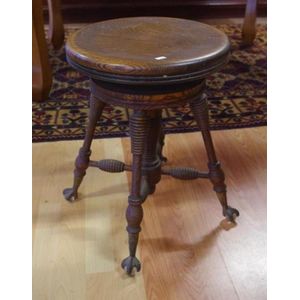Adjustable Edwardian Piano Stool with Ball and Claw Feet
You must be a subscriber, and be logged in to view price and dealer details.
Subscribe Now to view actual auction price for this item
When you subscribe, you have the option of setting the currency in which to display prices to $Au, $US, $NZ or Stg.
- Ball and Claw Feet - Are in the shape of a rounded ball, attached to the underside of the carcase by a wooden shank. Introduced during the late 17th century and found on furniture in the William and Mary and Queen Anne style, are commonly found on cabriole legs in the manner of Thomas Chippendale, and furniture imitating the mid-18th century Rococo style. The leg terminates in a ball held by a carved lion's or bird's claw.
- Claw Feet - Carved or cast in the shape of a lion's claw or the talons of other more fabulous beasts. They may be found on chair and table legs, supporting platform bases, and cabinets in the Classical Revival manner. Claw feet are not uncommon on Australian furniture made throughout the 1850s and 1860s, though, as with all forms of carving, the deeper and richer the claws are carved, the earlier the piece is likely to be.
- Turned Legs - are legs which have been turned on a lathe. In use from the 16th century, turned legs on tables, chairs and cabinets became more frequent until, by the 1830s, the Georgian square or tapered leg was rarely found except in country pieces.
- Edwardian - The Edwardian period of English furniture and decorative arts design is named for Edward VII (1841 ? 1910) who was King of the United Kingdom and the British Dominions and Emperor of India for the brief period from 1901 until his death in 1910. It follows the Victorian period, in turn was followed by the Art Nouveau and Art Deco styles. In Australia, designs of this period are also known as being in the Federation style.
- Turning - Any part of a piece of furniture that has been turned and shaped with chisels on a lathe. Turned sections include legs, columns, feet, finials, pedestals, stretchers, spindles etc. There have been many varieties and fashions over the centuries: baluster, melon, barley-sugar, bobbin, cotton-reel, rope-twist, and so on. Split turning implies a turned section that has been cut in half lengthwise and applied to a cabinet front as a false decorative support.
This item has been included into following indexes:
Visually similar items

Fine antique late 19th century French floral marquetry inlaid table jardiniere, fitted with lift off cover, and bronze mounts, 60 cm wide


A good mid-Victorian mahogany extending dining table, 1860s/'70s, possibly Scottish, the top (with two spare leaves) with semi-circular ends above a plain frieze raised on a pair of baluster supports, each on a pair of out-swept feet with foliate-carved kn

A Victorian mahogany extending dining table, mid-19th century, the top (with one spare leaf) with semicircular ends and edges banded in satinwood raised on turned screw-in legs. Height 73 cm length 155 cm (extended with the one spare leaf) width 121 cm, nO
